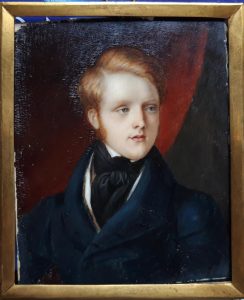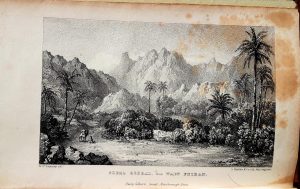William Wardlaw Ramsay
The oldest child of Lady Anne and Robert Wardlaw Ramsay, William was the repository of their hopes and dreams. His mother drew many pictures of him in his petticoats. She took pleasure in teaching him and soon he could draw, sing, play the flute, and hold his own in drawing room performances; the plan was to make a lawyer of him. After leaving home, he maintained a regular correspondence with his family and friends. Many of these letters can be viewed in the National Archives and the Lindsay family papers.
His first travels abroad happened after he had left school. He begged to be allowed to go on the Grand Tour, before starting his studies in Oxford, where his cousin Alexander Lindsay had already started.
According to his passport, Robert was blond, grey-eyed, with a long nose, a medium mouth, blond beard and an oval face. He was a susceptible young man and, during his Grand Tour, fell in love with a British girl who was living in Lucca with her family. His father travelled out post haste to put an end to the relationship, grievously offending the girl’s father, a Major, and presumably the young lady, in the process. In Basel, he met up with his younger brother Robert and his tutor, and they travelled home together, an energetic journey that Robert recorded in his journal.
After completing his degree (finishing 17th in his year) William persuaded his parents to allow him to defer his legal studies, and accompany Alexander Lindsay on a journey through Egypt, the Near East and the Holy Land. This was an ambitious and expensive project, but the tour was becoming an essential trip for a new generation of students, keen to discover the facts behind the Bible. William travelled to Rome for the winter, where he was taken up by another young woman Miss L.T.H, who showed him around the churches and introduced him to the Catholic faith. He found this so appealing that he started catechism classes in the Scots College. This step caused further dismay among his relations, whose letters were at pains to show him the error of his ways. When in Rome, Robert commissioned his portrait from the fashionable miniaturist Bonfigli.

Clementi, Bonfigli, Albano… Roman artists
His red hair is much in evidence.

Cousin Alexander was a staunch Protestant, so William’s parents felt confident that their son would not succumb to further blandishments during their tour of Egypt and the Middle East. The cousins had many adventures, which William reported on with gusto in his letters and journal. However, when they reached Damascus, he succumbed to the cholera and died. This was 1837. His cousin was distraught and arranged for the body to be transported, in contravention of all the quarantine regulations, back to Scotland, where it was buried at Whitehill Mains.
Among the many relics of this fateful journey is William’s Wallet, now in the Scottish Archives (GD143/147) , which contains mementos of his trip, and diary entries. His drawings have not survived, although two were included as engravings in Alexander Crawford Lindsay’s Letters on Egypt, Edom and the Holy Land, London, 1838. Alexander wrote it on board ship, while waiting for clearance to convey the coffin to Scotland. He quotes extensively from his cousin’s own journal, referring to him initially as Mr Ramsay. This description of Wady Feiran, which they reached in the course of a romantic camel ride through the desert to St Catherine’s monastery, records a magical experience: “Gebel Serbal was of a bluish grey, but the jagged rocks of the valley… were black, the bright lights and deep broad shadows rendering them perfectly beautiful. I sat on my dromedary under a tarfa tree, enjoying the shade and a delightful breeze, and talking with the Bedouins, while William sketched this lovely scene.” Vol 1. p. 328. https://archive.org/details/lettersonegypte02crawgoog

William’s sketch of Gabel Serbal from Wadi Feiran as the frontispiece to Vol 2 of “Lord Lindsay’s Letters on Egypt, Edom and the Holy Land”